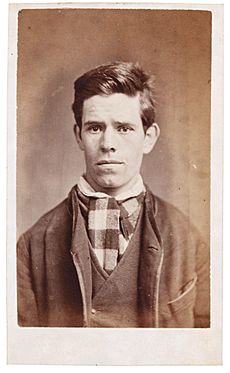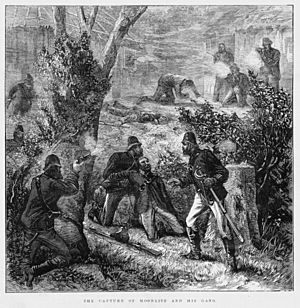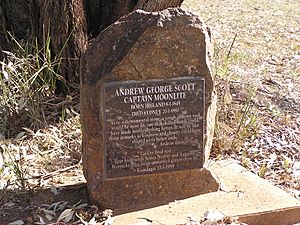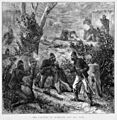Captain Moonlite facts for kids
Quick facts for kids
Captain Moonlite
|
|
|---|---|
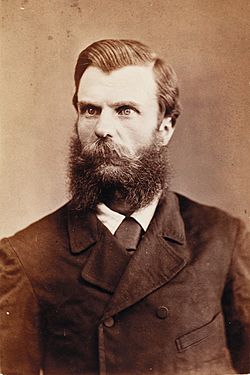 |
|
| Born |
Andrew George Scott
5 July 1842 Rathfriland, Ireland
|
| Died | 20 January 1880 (aged 38) Sydney
|
| Resting place | Gundagai |
| Other names | Captain Moonlite Captain Moonlight |
| Occupation | Bushranger, public speaker, gold digger, bank robber, combatant |
| Criminal status | Executed by hanging |
| Parent(s) | Father: Thomas (Church of England Minister) |
| Criminal penalty | Death |
| Partner(s) | James Nesbitt |
Andrew George Scott (born 5 July 1842 – died 20 January 1880) was an interesting figure in Australian history. He was born in Ireland and later moved to New Zealand, then Australia. He became known as Captain Moonlite and was a famous bushranger in the Australian colonies of Victoria and New South Wales. Today, he is still remembered as an important part of Australian folk stories.
Contents
Early Life and Adventures
Andrew George Scott was born in Rathfriland, Ireland. His father, Thomas Scott, was a minister in the Anglican church. His father wanted him to become a priest, but Andrew chose to study engineering in London instead.
In 1861, his family moved to New Zealand. Andrew hoped to find gold in the Otago goldfields. However, he ended up joining the army during the New Zealand Wars. He fought in the battle of Orakau and was hurt in both legs. After he recovered, he was accused of pretending to be sick and faced a military trial. He explained that he did not want to return to fighting because he was upset by the violence.
Later, in 1868, he moved to Melbourne, Australia. He met a bishop named Charles Perry. Andrew became a lay reader (someone who helps with church services) in Bacchus Marsh, Victoria. He planned to become an Anglican priest after this service. He was then sent to a gold mining town called Mount Egerton.
Becoming a Bushranger
On 8 May 1869, Scott was accused of robbing a bank. He was said to have disguised himself and forced a bank agent to open the safe. After this, he went to the Maitland area in New South Wales. There, he was found guilty of tricking people out of money. He was sentenced to prison for 15 months.
After his release, he returned to Sydney. In March 1872, he was arrested again for the bank robbery in Egerton. He was sent to Ballarat for trial.
Escaping Prison
Scott managed to escape from jail. He cut a hole in his cell wall to get into the next cell. He and another prisoner then captured a guard, tied him up, and used his keys. They freed four more prisoners, and all six men escaped over the prison wall using blankets tied together like a rope. Scott was later caught again and held until his trial.
In July, he was tried in Ballarat. He defended himself in court, making the trial last eight days. Despite some evidence against him, he always said he was innocent of the bank robbery. He was found guilty and sentenced to 10 years of hard labor.
Scott served about two-thirds of his sentence. He was released from HM Prison Pentridge in March 1879. After leaving prison, he earned some money by giving talks about his experiences in jail. He also met James Nesbitt, a young man he had met in prison. With Nesbitt's help, Captain Moonlite began giving public speeches about how prisons could be better.
However, his fame also caused problems. The police and newspapers watched him closely. They tried to connect him to many crimes and spread rumors about his plans.
Around this time, Scott decided to live up to his reputation. He gathered a group of young men. Nesbitt was his second-in-command. The others were Thomas Rogan (21), Thomas Williams (19), Gus Wreneckie (15), and Graham Bennet (18). Scott had met these young men during his lecture tours.
The gang started their bushranging near Mansfield, in Victoria. They were often mistaken for the famous Kelly Gang. They used this to get food and take guns from farms. The gang left Victoria in late 1879. They traveled north into New South Wales to find work, away from the police. It was in southern New South Wales that they became more active as bushrangers.
On Saturday evening, 15 November 1879, they became very well known. They entered the small town of Wantabadgery, near Gundagai. There, they "bailed up" (held captive and robbed) all the people living there.
Capture of the Gang
Scott's gang held up the Wantabadgery Station on 15 November 1879. They had been refused work, shelter, and food. They were very hungry and desperate after spending cold, rainy nights outside. They took control of the station, holding the owner's family and staff captive. Scott also robbed a hotel and took more people prisoner, bringing the total to 25. One man escaped to warn others but was caught.
A small group of four mounted police officers arrived. Scott's gang, who were well-armed, captured the police horses. They kept the officers pinned down with gunfire for several hours. The police then left to get more help. The gang slipped away and hid in a farmhouse belonging to Edmund McGlede. Soon, five more police officers, led by Sergeant Carroll, surrounded the farmhouse.
During the shootout, a young gang member named Gus Wreneckie was shot and badly wounded. He was paralyzed and later died. The police slowly moved closer, pushing the gang into a back kitchen. Sergeant Carroll led an attack on the kitchen. During this, Constable Edward Webb-Bowen was shot in the neck and died. Investigations later suggested Wreneckie might have fired the shot.
Nesbitt was also shot and killed. He was trying to draw the police away so Scott could escape. When Scott saw Nesbitt fall, he was distracted. McGlede took the chance to disarm Scott. With the other gang members wounded or captured, the fight ended. Rogan managed to escape but was found later hiding under a bed. Newspapers reported that Scott cried openly when Nesbitt died.
Trial and Execution
Scott was accused of firing the shot that killed Constable Webb-Bowen, but he denied it. Witnesses said Scott had a sniper rifle, but the policeman died from a bullet fired by a Colt's pistol. It was never found out who used that pistol during the fight. Scott was found guilty, even though he tried to take all the blame himself to protect his companions. The jury asked for mercy for three of the other gang members.
Scott and Rogan were hanged together in Sydney at Darlinghurst Gaol on 20 January 1880, which was Scott's father's birthday. While waiting to be hanged, Scott wrote several letters from his prison cell. These letters were later found by a historian. Scott's last wish was to be buried in the same grave as his close friend, James Nesbitt. The authorities did not grant his wish at the time. However, in January 1995, his remains were moved from Rookwood Cemetery in Sydney. They were reburied in Gundagai, next to Nesbitt's grave.
Images for kids


